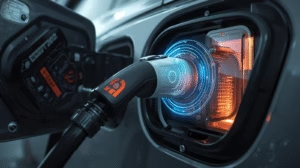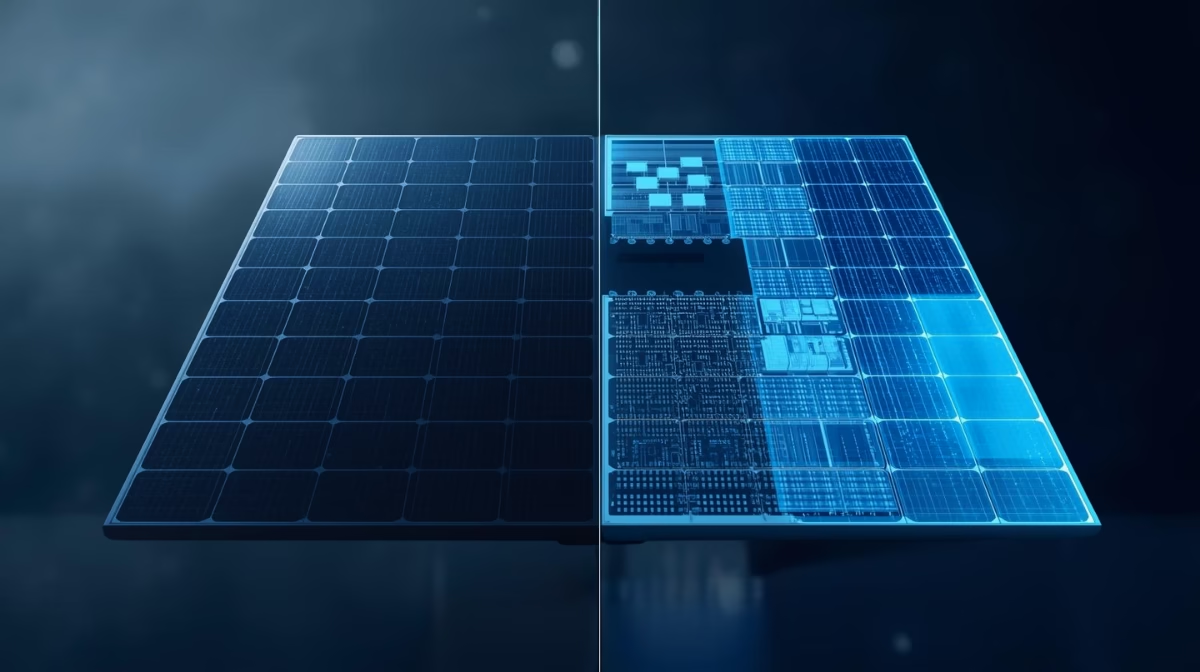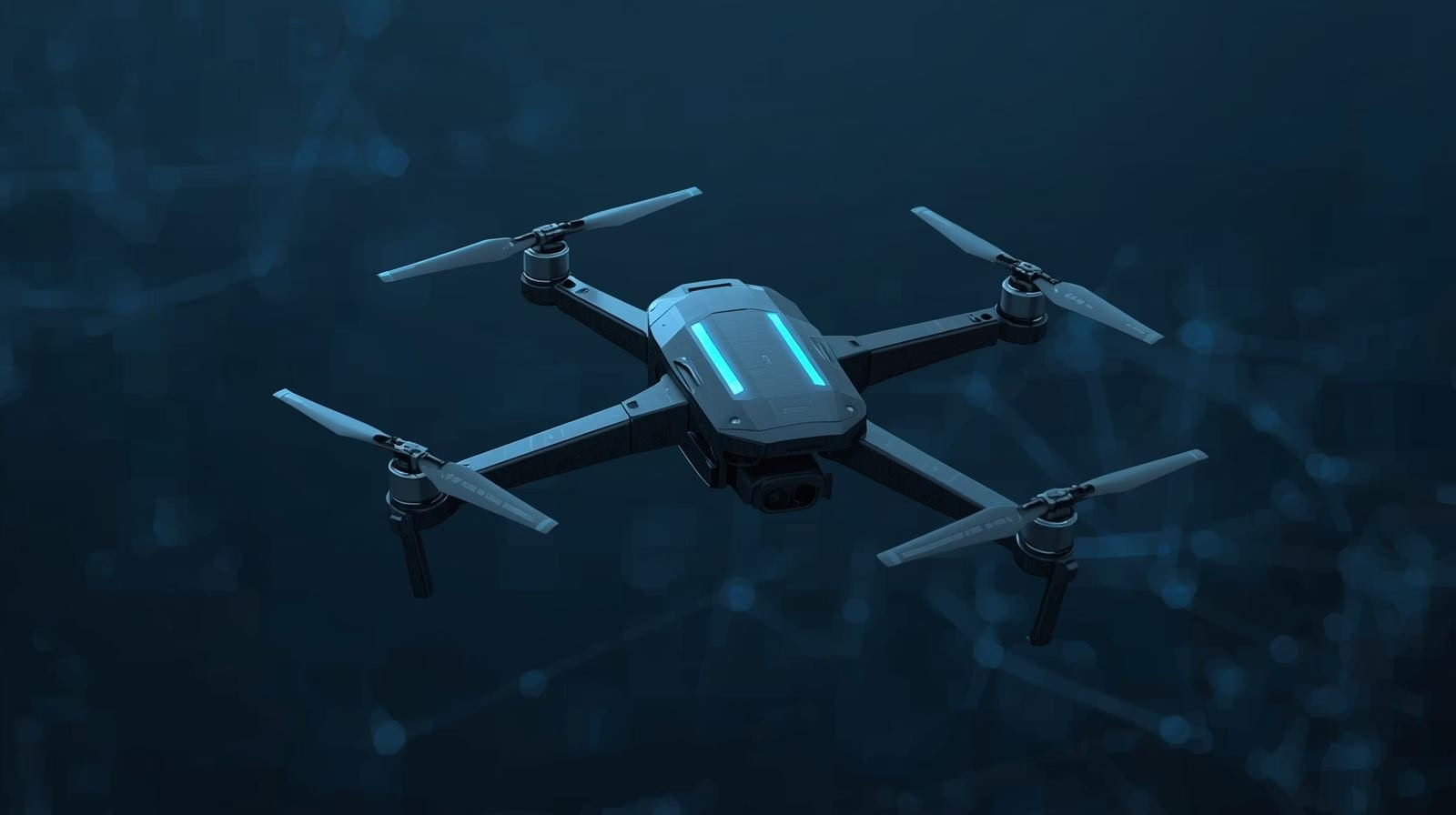The hidden power behind faster and more efficient EV charging is n’t magic-it lies in advanced magnetic technologies. Syrma SGS is already a recognized manufacturer in supplying high-performance magnetic components worldwide. As demand for faster and more efficient charging grows, Syrma SGS is engineered to optimize its reliability and performance in real-world deployments.
We use magnetic technology as the core intelligence to make charging not only fast and safe but also a competitive advantage for our partners. We don’t think this is just a manufacturing part; it’s about driving a future of electric mobility from its magnetic core.
What Really Powers Your EV Charger? Magnetic Components Explained
Syrma designs high-frequency inductors and transformers to regulate voltage, filter noise, and ensure stable power delivery to a battery. Enabling a high-power magnetic solution is essential to transfer electricity from the grid into the controlled power required by an EV battery. For example: A common level 2 home charger is delivering 7-22 kW, which fundamentally relies on these magnetics to manage electricity flow and protect the vehicle from grid fluctuations. Our magnetics are equally critical for converting high-voltage AC from the grid into the high-power DC to make charging more efficient. It ensures the end-users can have a safe and reliable charging experience.
The Quiet Backbone of EV Charger Efficiency
Beyond the efficiency of batteries and electric motors, magnetics are the unsung heroes of EVs’ transformation. Their seamless and reliable operation is a key to enabling a dependable EV charging ecosystem. Using higher-efficiency magnetics reduces the amount of energy wastage as heat and helps more power be delivered to the battery. The power conversion rate of modern EV chargers typically exceeds 95 – 97%, which largely depends on magnetic cores and windings. It not only saves your electricity but also minimizes the thermal stress, improving the long-lasting performance of the entire charging unit. This is especially vital for reducing the sophistication of cooling requirements for chargers delivering hundreds of kilowatts.
Core Functions of Magnetics in EV Charger
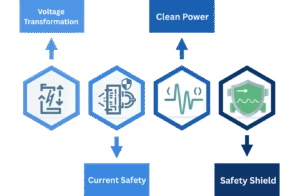
Our engineering team precisely focuses on current regulations, EMI suppression, and voltage transformation to meet the exact requirements of global EV charger OEMs. While the magnetics are the critical backbone of an EV charger, we facilitate several core functions to optimize its performance and reliability. They include:
Voltage Transformation: The electricity voltage is precisely adjusted (up or down) to match your EV battery needs.
Current Safety: It controls the flow of electricity to prevent the battery from being damaged or overcharged.
Clean Power: They restrict the noise or inconsistencies present in the electricity to protect sensitive electronic components.
Safety Shield: They create an electrical barrier between the grid and the vehicle to prevent shocks and ensure safe charging.
How Magnetics Bridge the Gap Between AC and DC Charging
From on-board chargers to high-power DC fast chargers, Syrma SGS supplies inductors and transformers optimized for safe, efficient AC-DC conversion. The integrated specifications are tailored according to the manufacturer’s requirements.
In general, EV batteries run on DC power; however, the electrical grids primarily supply AC power. In this conversion process, our magnetic components play an essential role. Let’s discuss how it works:
On-Board Charger – AC to DC (Charging at Home): We’re providing magnetic components for common level 1 (e.g., 1.9 kw @ 120V) or level 2 (e.g., 7.7 kw @ 240V) charger, where the conversion of AC to DC power happens inside the vehicle. Our engineering team designed inductors to enable the most efficient conversion possible within the vehicle’s on-board charger.
DC Fast Chargers (High Power AC to DC): Our high-frequency transformers and large inductors are essential for quick top-ups. They can transform strong AC power (e.g., 480V three-phase power) from the grid into high-voltage DC (e.g., 400V to 1000V). This is particularly for rapid battery charging, moving current that exceeds 500 amperes.
Breaking Down the Magnetic Building Blocks of a Charger
Syrma SGS develops magnetic building blocks (power transformers, current sensors, and inductors) using high-grade amorphous metals, nanocrystalline cores, and ferrites. They are tested for high-temperature, high-current performance, and high-frequency in EV charging environments. Let’s uncover the hidden world of magnetics within an EV charger:

Power Transformers: Voltage Changers and Safety Guards
Our transformers are engineered to change the electricity’s voltage to exactly what your battery needs. In high-power DC chargers, they require specialized core materials like ferrites or amorphous metals to operate seamlessly at high frequencies (e.g., tens to hundreds of KHz). It allows the smaller and lighter transformers that are incredibly efficient to convert over 98% of the power without waste. They also act as a safety barrier, creating a bridge between vehicle and grid.
Inductors: Power Smoothers
We design inductors as key components to smoothing out the power flow, energy storage, and power factor correction. They’re available in various sizes, from smaller filter inductors in DC-DC converters to larger input inductors for AC rectification.They are essential for handling strong, fluctuating currents, often operating reliably at temperatures up to 150°C
Current Sensors: Unseen Eyes
Our magnetic sensors, including hall effect sensors, and current transformers measure the electric flow within the charger. They are crucial to prevent overcurrent and indicate to the charger how much power to deliver. Such sensors also ensure everything (current, voltage, and temperature) stays within the safe limits.
EV Magnetics and the New Frontier of Engineering
Syrma SGS extends the boundaries of magnetic components to meet the evolving demand of EV charging. We develop custom magnetics for advanced cooling, high-frequency operation, and high power density designs. It ensures optimal thermal management and compliance with automotive and safety standards.
Miniaturization and Power Density: Syrma specializes in achieving higher power densities over 50 kW per liter in compact charging modules. Our custom-designed magnetics are incredibly efficient and can manage excessive power in tiny volumes.
High-Frequency Operation: While moving to higher switching frequencies (e.g., >100 kHz), modern EV chargers use some smaller and lighter magnetic components (like transformers). It increases resistance and heat, causing skin and proximity effects. To overcome these challenges, we are designing innovative winding strategies and selecting advanced materials, allowing the components to operate reliably and efficiently.
Thermal Management: The increased power density in tiny compressed modules causes higher heat generation. Therefore, we utilize advanced magnetic materials and innovative cooling techniques to control operating temperatures within limits (for instance, maintaining core losses from not exceeding 1 W/cm³). It helps maintain component longevity in EV environments.
Meeting the Demands of the Electric Revolution with Magnetics
The electric revolution insists the charging infrastructure is not only powerful but also reliable and economical. Magnetics are used as a key to achieve such requirements:
Cost-Effectiveness: Integrating advanced magnetic components reduces the overall cost of an EV charger. This is because the right ones allow chargers to be built lighter, require fewer cooling techniques, and have fewer expensive parts. It helps engineers to make chargers more affordable.
Scalability: The increasing volume of EV usage demands charging points worldwide. It is possible while using magnetic components. Just because their designs are standardized, the vast charging network can be made quickly using automated factories.
Crafting the Future of EV Charging from the Magnetic Core
Syrma utilizes advanced winding techniques, next-gen core materials, and integrated magnetics to drive smaller, lighter and efficient magnetic components. Beyond occupying lesser space, the EV charging technology is literally transformed and offers tangible benefits for your products.
New Magnetic Materials: We use innovative composite materials (ferrites and nanocrystalline materials) and alloys with exceptional magnetic properties committed to providing improved reliability, faster charging, and greater energy efficiency. It allows us to offer higher saturation flux density and lower energy losses, even at high temperatures.
Integrated Magnetics: By integrating multiple magnetic functions into single components, we efficiently reduce the assembling complexity, space, and part count. Our innovative solutions can help you to save sizes up to 25 to 30% in magnetic subsystems.
Advanced Winding Techniques: When the electricity passes at high speed, it causes parasitic effects like winding capacitance and leakage inductance. To overcome these parasitic effects, we employ an advanced winding technique that can distribute the current evenly and reduce uneven flow. This means the magnetic components can run efficiently while handling large amounts of power at high speeds.
The Next Wave of Magnetic Innovation in EV Charging
The functionalities of EV charging are continuously evolving, and the following are the next big advancements:
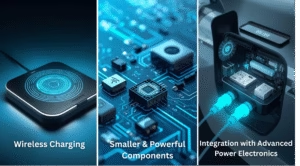
Wireless Charging: Just imagine your EV is parked in a public spot, and it starts charging automatically. It is wireless charging, which entirely relies on specialized magnetic coils. Their ultimate goal is to transfer power through the air (with 90-95% efficiency), even while driving.
Smaller and Powerful Components: Engineers are developing magnetic components to make EV chargers more compact and efficient. It is intended to handle massive power at high frequencies.
Integration with Advanced Power Electronics: The future of EV chargers will be integrated with advanced semiconductors like Gallium Nitride (GaN) and Silicon Carbide (SiC). These materials transfer power much faster and more efficiently. It also makes the charging system more compact and powerful, extending the boundaries of speed and reliability.
Magnetic Breakthroughs in EV Infrastructure
From public charging networks to heavy-duty vehicle infrastructure, Syrma SGS magnetics are already powering advanced charging solutions in the field. Our innovative solutions transform the entire EV network and pave the way for a more reliable and efficient future.
Megawatt Charging for Heavy Duty Vehicles: Syrma provides next-gen magnetic components for new megawatt charging systems (MCS). They are designed to deliver 1000 kilowatts or more of power to charge a bus or electric truck in minutes. Our magnetics are precisely designed to manage the incredible heat generated due to high power transfer.
EV as Power Banks: Bidirectional Charging – Our advanced technology not only allows your EV to charge from the grid but also sends back the power to the grid when needed. We provide precise control over the two-way charging and ensure they are safe and stable.
Magnetics are Powering the Future of EV Charging
The future of electric vehicles is not only about motors and batteries, it fundamentally includes magnetic components to enable a faster, and reliable charging experience. When the industry runs towards higher power and seamless integration, the need for efficient magnetic components is essential than ever.
Syrma solutions are engineered for EV infrastructure, power electronics designers, EV charger OEMs, and Tier-1 automotive suppliers. We design and develop a full suite of magnetic components for chargers from 10 kW to 240 kW. They include EMI filters, DAB transformers and inductors, PFC chokes, Gate driver transformations, and Grid inductors. We customize all of our components to provide competitive advantages to our clients. As we are already working with recognized OEMs in the EV charging segments to provide efficient components, helping build a smarter, more sustainable, and electrified future.
Disclaimer: Images used in this Blog are AI generated

